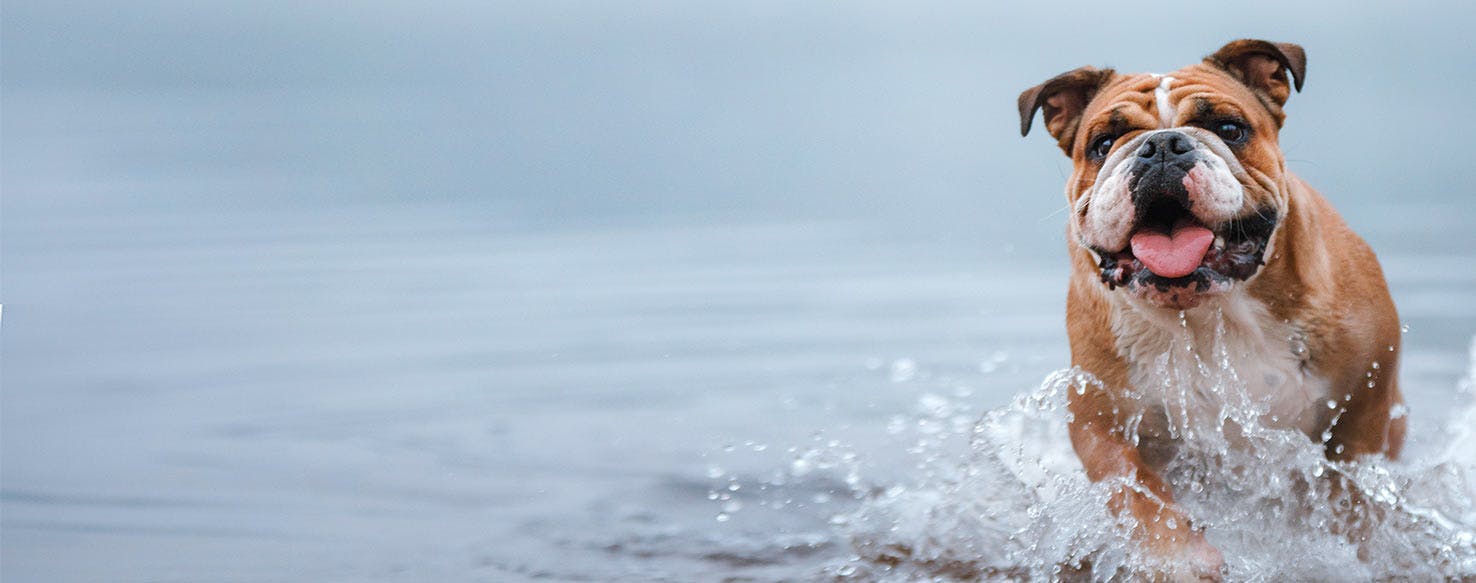- Home
- The Daily Wag!
- Behavior
- Why Don't Bulldogs Swim
Why Don't Bulldogs Swim

Common
Concerning
Introduction
Bulldogs come in a number of varieties including French, American, English, and the Old English Bulldogge. Each has a different set of physical characteristics, including size and weight, but most share a few similarities, including the “smooshed” face like Pugs, thick muscles, and heavy bones. All of these features add up to a dog that isn’t built for swimming. You may have seen videos of Bulldogs swimming before and wonder why some do and some don’t. Why can’t some Bulldogs swim? Should you take your Bulldog swimming? What if you have a dog who loves the water? How can you keep your Bulldog safe?
The Root of the Behavior
Dogs like the English Bulldog, French Bulldog, and Pug—those breeds that have that characteristic smooshed face—are called brachycephalic, which means they have a short, wide skull. Brachycephaly has been a desired trait for many generations of dog breeders, all for purely cosmetic reasons. The smooshed face that many owners find adorable and irresistible has actually resulted in a number of other health problems in these breeds. Dogs with brachycephaly often suffer health problems resulting from their short nasal passages and wrinkled faces. Snoring and snorting, for example, often mean that the dog’s airway is partially obstructed, which can become worse over time and lead to respiratory issues. The core reason why Bulldogs and similar breeds can’t swim is actually because of their Brachycephaly. Their short snouts mean that they have to tilt their faces up higher to keep them out of the water. Dogs tilted up thus have more difficulty staying afloat. Especially since their short legs and heavy torsos are not conducive to flotation.
You might have seen videos of Bulldogs swimming before, or maybe you’ve had one who could swim just fine. But don’t take this as assurance that every Bulldog can swim or should without precautions. Exhaustion and even high humidity can have an impact on your dog’s ability to stay above water. All it takes is one small mistake for your dog to suffer unfortunate, lethal consequences. Brachycephaly isn’t the only reason Bulldogs can’t swim. They, in addition to Basset Hounds, Dachshunds, Pugs, Corgis, and Maltese are some of the breeds best left out of the water. Short-legged breeds often have difficulty swimming, and the Maltese are highly prone to chills, arthritis, and rheumatism, which can be exacerbated by swimming in cold water. Even Pit Bulls and Boxers may sometimes have difficulty swimming since muscle weighs more than fat and those short snouts may be hard to keep out of the water. Any “top-heavy” dog with a dense torso or a large head may find it difficult or impossible to keep their heads out of the water. Always consult your vet before taking your dog into deep water and always take precautions.
Need advice about your pet's health?
Get answers fast from a veterinary professional 24/7 in the Wag! App.
Get Vet ChatEncouraging the Behavior
You can still enjoy the water with your Bulldog, but you should always take precautions. You can enjoy the water in shallow pools in the backyard, or a shallow creek. Even a sprinkler, if your dog doesn’t mind being sprayed with water. Just be careful not to let your dog drink too much water or snap at the hose for too long, as your dog can suffer something called water intoxication, which can become fatal if untreated. If you want to take your dog to the ocean or a deep pool, you should make sure your dog has the right swimming instincts. Not every puppy knows how to swim, and heavy-built breeds, even small ones like French Bulldogs, can sink quickly.
Additionally, you should purchase a life vest for your dog. Canine life vests are easy to find in most pet stores during the summer, or are available online the rest of the year. If your dog is going to be in water over their head at all, make sure you have a life vest ready and that your dog is comfortable wearing it. You can prepare ahead of time by getting your dog used to wearing the vest and rewarding them for staying calm. If you’re going out on the ocean or anywhere with a strong current, it’s a good idea to bring a life vest for your dog regardless of breed, size, or shape.
Other Solutions and Considerations
Most dogs love water. But not every dog instinctively knows how to swim. Those who don’t can be trained to enjoy it with patience and practice. You can consult your vet or a professional trainer for advice on introducing your dog to water and encouraging water play. You should also be cautious taking your dog out during the summer months as many breeds are susceptible to heat-related illnesses. Keep cool and stay in the shade as much as possible. Always bring plenty of fresh water for your dog to drink and, if you’re in the water, bring a life vest for all your family members, even the four-legged ones.
Conclusion
Swimming can be a great form of exercise and a perfect way to keep cool, both for you and your pet. But not every dog should be allowed in the deep water. Just like people, some dogs are not great swimmers. Play it safe by bringing a life vest and keeping a close eye on your dog.
Written by a Border Collie lover Charlotte Perez
Veterinary reviewed by:
Published: 03/29/2018, edited: 01/30/2020
More articles by Charlotte Perez
